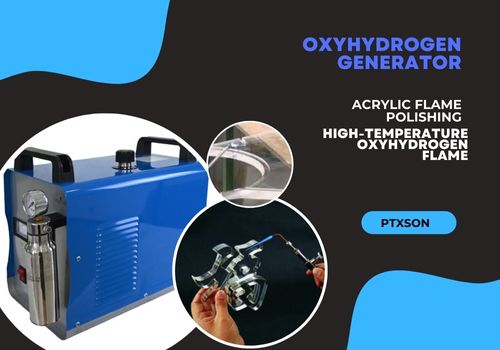The guide on how to use oxyhydrogen generator for acrylic polishing
Many customers ask us about how to use of oxyhydrogen generator for acrylic flame polishing correctly. Here we guided you step-by-step on how to operate the machines correctly and perform regular maintenance to ensure optimal performance in their daily operations.
1. Timely Water Refilling: Monitor the liquid level indicator closely. If the level drops significantly, add pure water immediately. There is no need to add electrolytic liquid.
2. Electrolytic Powder Maintenance: Add a suitable amount of electrolytic powder when the current significantly drops.
3. Ongoing Usage Steps: After the initial setup, steps 1 and 2 are the main actions required. If the electrolyte becomes dirty or ineffective after three months, especially due to alcohol contamination, it will need replacing. To change the electrolyte, carefully turn the machine upside down to drain it, flush the electrolytic tank, and refill with fresh electrolyte.
4. Water Refilling Precautions: Before adding or changing water, ensure the flame torch and power supply are turned off. Slowly unscrew the nut and add pure water between the high and low water lines. Once done, tighten the nut and restart the machine.
5. Managing Water Accumulation: If water collects in the rubber hose, the oxyhydrogen flame may turn yellow. To prevent this, discharge the water from the hose as needed.
6. Alcohol Level Management: The alcohol level in the auxiliary tank should not exceed the tank’s opening. If it does, unscrew the tank cap and drain the excess alcohol.
7. Checking for Air Leaks: Regularly inspect the rubber hose connections to ensure there is no air leakage.
8. Handling Electrolyte Spills: In case of accidental contact with the alkaline electrolyte, wash the affected area thoroughly with clean water.
9. Pressure and Current Monitoring: When turning on the machine, the pressure indicator should read around 0.1 MPa. If the current indicator returns to zero and the pressure remains stable, this means the machine is not leaking air. If the pressure drops and the current rises again, the machine is functioning normally.
The acrylic flame polishing oxy-hydrogen generator offers several advantages for your polishing needs. This tool is environmentally friendly and delivers precision and safe concentrated flame with an anti-backfire device. Its high efficiency in producing high-quality and smooth acrylic surfaces makes it an essential addition to clear and polished results.

TX-HO100 100L/h oxyhydrogen acrylic flame polisher
Using an acrylic flame-polishing oxy-hydrogen generator requires careful attention to maintenance, such as monitoring water levels, managing electrolyte quality, and checking for gas leakage. With proper handling, this oxy-hydrogen electrolysis technology ensures high-quality, efficient acrylic polishing. Regular training and adherence to best practices will ensure working performance and lifetime.
Our technical team ensures that customers not only understand the operational details but also the best practices for maintaining these machines for long-term use. We’re proud to provide comprehensive training to help customers get the most out of our hydrogen-oxygen solutions for acrylic polishing.
The oxyhydrogen generator uses electrolytic powder (potassium hydroxide) plus purified water solution
as electrolyte liquid,and adopts the principle of water electrolysis to electrolyze hydrogen and oxygen gas from water. Hydrogen is used as the fuel gas, oxygen is used as the combustion gas, and hydrogen oxygen gas is mixed in the optimal combustion ratio of 2:1.
HHO hydrogen generator for boilers consumes water and electricity, electrolyze water into hydrogen gas and oxygen gas, we can use H2 and O2 as source of flame replacing LPG, Propane, Acetylene fuel or natural gas or other oil. For different types of industrial gas/oil fired steam boilers and burners,hho gas can be added for complete combustion and saving energy 10-30%.
The portable hydrogen water generator machine uses advanced SPE electrolysis technology for purified hydrogen water production.